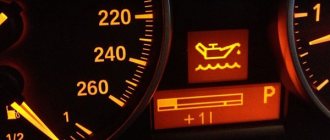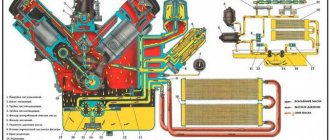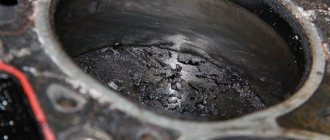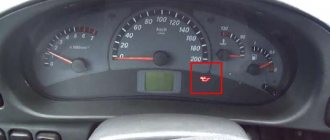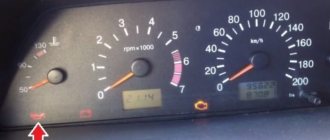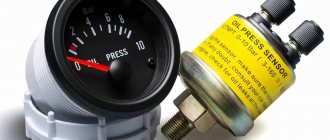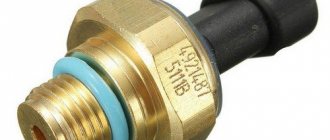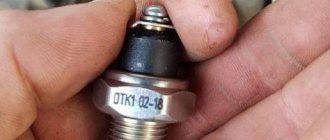The main reasons for the oil pressure warning light to come on
So, the warning light usually lights up after starting the engine or when it is idling. There may be several reasons for this phenomenon, but the main thing is to understand and accept for yourself that this should be a signal that there is some kind of malfunction. Therefore, you need to take appropriate measures so as not to worsen the situation. In any case, if the lamp blinks, it means that you need to identify the malfunction and do everything to eliminate it as soon as possible.
Among the main reasons for the indicator to light up are the following:
- Reduced lubricant pressure in the system. This is one of the most common reasons, but even today there are owners who stubbornly do not notice signs of oil leakage or do not look into the engine compartment. Why does pressure drop, you ask? Because the oil gradually leaves the system. Therefore, you should pay attention to any stains on the engine or under the car where it is parked. Do not forget that by simply adding lubricant to the system, you do not solve the problem, but only forget about it for a while.
- Another reason for the warning light to blink is due to the use of low-quality oil filters. Some of the lubricant remains in them even when you stop the engine. If the filter is of dubious quality, then it does not retain oil, but it directly flows into the crankcase. Thus, a periodic drop in pressure occurs.
- Lack of lubrication may be associated with failure of the pressure relief valve. It should be in the closed position if the pressure level in the system is insufficient. However, when the valve fails or gets stuck, the pressure generated is not enough, which causes the warning light to light up.
- Another reason is a faulty pressure sensor. It is directly related to the operation of the control indicator, since it is connected to it by the same wire. As soon as the pressure returns to normal, the contacts should open, as a result of which the indicator should go out. This will not happen if the sensor itself has become faulty.
- The indicator also starts blinking if the oil pump screen is clogged. It acts as an obstacle to particles of dirt, metal, dust and any other unwanted elements that lead to wear on the pump. If the oil is not dirty, but of normal quality, then it freely penetrates through the mesh. When it is contaminated, the required pressure is not created in the system, which leads to the warning lamp coming on. Most often, this reason manifests itself on a cold engine, because as it warms up, the lubricant becomes more liquid and passes through the mesh much more easily.
- The oil pump itself may also fail. It is this that creates an acceptable level of pressure in the entire system. If this does not happen, the sensor contacts close, which leads to the appearance of a signal indicator on the panel. Therefore, in this case, you will have to dismantle the oil pan and pump to eliminate the problem.
Where is the sensor located?
Good to know
On most vehicles, the meter is installed in close proximity to the cylinder head and oil filter.
In order to gain access to the device, you may need to remove the wheel or crawl under the bottom of the car.
Location of the oil pressure sensor
Table: location of DDM on popular car models
| The model of car | Place where the measuring element is located | How to access the controller |
| Lada Kalina (Lada Kalina) | The oil pressure gauge is located on the right rear part of the power unit - in a separate socket of the main cylinder block next to the belt guard. One cable must be connected to the controller. | At the top of the motor. To gain access, the user must remove the plastic cylinder block cover. |
| VAZ 2108/2109/21099 VAZ 2110/2111 (8 valve engine) | The device is located on the right side of the power unit, in a special socket in the cylinder head, next to the belt protective shield. One cable must be connected to it. | Above |
| VAZ 2110/2111 with 16 valve engine | The controller is located at the rear of the power unit on the camshaft block. One cable is connected to the measuring element, next to it there are two bundles of wires enclosed in black insulation. | Above |
| Audi (Audi) - most of the modern models | Near the oil filter device. Depending on the model, there may be an additional meter located on the main cylinder block. One cable is connected to the pressure sensor. | At the top of the engine |
| Chevrolet Lanos (Chevrolet Lanos) | On the oil pump device from the bottom of the power unit. A bundle with cables in a separate insulator must be connected to the sensor. | At the bottom of the engine. The device can only be accessed from under the bottom if the machine is located on a pit or overpass. |
| Ford Transit | In the middle under the front bumper of the car, next to the oil cooler. | |
| Renault Trafic (Renault Traffic) | The engine contains a special device with an oil filter and a heat exchanger. The sensor itself is screwed into the thread on the channel after the oil filter. | Above |
| Mercedes-Benz (Mercedes Benz) - most of the modern models | On these car models, the oil pressure sensor is located on the crankcase on the right side of the central part of the car | At the bottom of the engine. The device can only be accessed from under the bottom if the machine is located on a pit or overpass. |
| Mitsubishi Lancer (Mitsubishi Lancer) | The sensor is located on the rear side, slightly to the right of the motor. The meter is screwed into the power unit next to the lubricant filter. One cable is connected to the sensor. | |
| Nissan X-Trail (Nissan X-Trail) | The device is located in the lower part of the cylinder block, next to the pumping device of the power steering system. | To gain access, the user must remove the right wheel and remove the plastic belt cover. |
| Opel Astra (Opel Astra) | The sensor is located at crankcase level on the right side of the generator set. One cable is connected to the controller. | To change and install a new controller, you need to remove the right front wheel |
| Volkswagen Golf, Jetta (Volkswagen Golf and Jetta) | The measuring device is located at the end of the cylinder head. These cars are equipped with two controllers, the second is designed to record insufficient pressure and is located on the oil filter to the right of the car. | The sensors are located at the top and bottom of the motor, respectively. |
| Volkswagen Passat | The car is equipped with two measuring elements. The first is located on a special bracket upstream of the lubricant filter, the second is located at the outlet of the filter. | Above |
| BMW E39 | The sensor is located on the oil filter cup and is parallel to the power unit. There are two controllers here, one records the temperature, the other records the pressure. | Above |
| Gazelle with power unit ZMZ-405 | The sensor is located on the right side of the main cylinder block, in its upper part. One cable is connected to the meter. | Above |
How does the oil sensor work and why can it fail?
Now let's consider the situation if you are on the road and the low pressure indicator has triggered. The very first thing you need to do is stop the vehicle and turn off the engine. As soon as it cools down, you will have to check the lubricant level in the system. There is a special dipstick under the hood for this purpose. It is wiped dry and immersed in its original place. It is quite possible that the level will be below the minimum level. This means that somewhere there is a leak or depressurization of connections. You can set off again only after adding oil to the engine. If the lamp continues to light after starting and does not go out subsequently, it makes sense to think about towing the car to the nearest service station or to a trusted auto mechanic. The matter may turn out to be quite serious, so it is advisable to conduct the examination in a calm environment.
Since we have already said that the causes of low pressure may be associated with a faulty sensor, it would be useful to understand the principle of operation of this device. There are certain contacts inside it. Until the ignition is turned on, there is no pressure in the system, so the contacts are closed. When you turn the key and turn on the ignition, but before the starter starts, the warning lamp should be on. If this does not happen, then there may be some kind of malfunction. Maybe the light bulb itself simply burned out, or maybe the contacts were broken or the sensor itself failed. As soon as we start the engine, the contacts open, leading to the light bulb going out.
Repair work after driving without oil
When an engine is running without good lubrication, the unit has very little chance of survival. Within a few minutes, the wear of the piston group reaches the maximum possible level. Gaining speed in this state of the engine will mean an almost guaranteed loss of vital activity of the unit. It is better to carry out repairs after the car has been evacuated, as soon as the light starts to burn. In this case, you can often get by with little expense. If the unit operates without oil, the problems can increase significantly:
- new problems will be added to existing problems to repair the engine due to its wear;
- the piston group is almost guaranteed to be replaced, which will make repairs unrealistically expensive;
- the entire oil supply system will most likely also be replaced at enormous expense on the part of the owner;
- the repair will have to be carried out at a professional station, because disassembling the engine is not an easy process;
- the use of low-quality parts will not work in this case, since the machine will completely lose reliability;
- A clear computer diagnosis is needed to help identify the affected nodes.
Diagnostics at the service center after a long trip without oil will truly surprise you with its scope. For inspections alone you will have to pay a very impressive amount of money. However, after such a situation, it is imperative to perform a good check of the car and obtain information about the damage caused. Often, after such adventures, it turns out to be much more profitable to purchase a new engine or contract power unit than to look for any solution to this problem. We invite you to look at self-diagnosis of a domestic car when the oil light is on:
How to check pressure
If it is not possible to contact a car service in the near future, you can try to find the cause yourself, and for this we need to find out how to check the oil pressure. A special device that measures the pressure in the system is designed for these purposes. It is sold ready-made or you can make it yourself based on any pressure gauge, a rubber hose with a fitting, the thread of which should be the same as that of the oil sensor.
First you need to unscrew the thread on the sensor, preparing for the fact that oil will immediately begin to flow. After this, a pressure gauge is inserted into the system and the engine is started. At the time of startup, a second person must watch the instrument readings. If the value is less than 0.5 kg/cm2, it is necessary to stop the engine.
